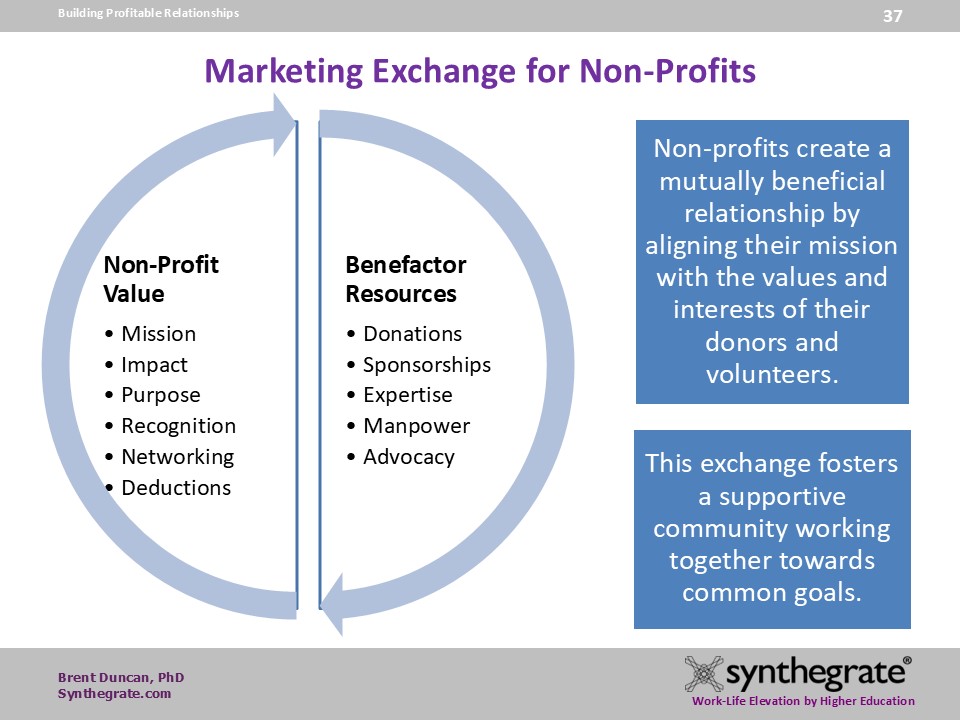Essential terms for non-profit marketing effectiveness
Before diving into the marketing plan, clarifying the terms and dynamics in a non-profit context is crucial. Essential terms and concepts include Exchange (you offer something of value in exchange for money and resources), Beneficiary (the recipient of your services; your mission), Benefactor (the entity that gives you the resources to operate; your customer), Product (the value you offer to the customer), and Objective (what your marketing will accomplish).
Exchange

Missing the reciprocal nature of exchange leads to viewing the mission as purely one-sided giving. Failing to highlight what benefactors gain from the non-profit mission can reduce engagement, decreasing resources necessary for operations.
At its core, marketing is an exchange process. You offer a product or service in return for payment. In the non-profit sector, this exchange takes on a unique form. The "product" might be the impact or services provided to beneficiaries, such as endangered species, disaster victims, or underserved communities, who receive these services at no direct cost.
Viewing marketing as an exchange process in non-profits highlights the need to offer unique value. Donors contribute financially, while volunteers offer their time. In return, the non-profit's marketing efforts provide satisfaction, acknowledgment, and a range of benefits linked to fulfilling its mission.
Beneficiary
Non-profit marketers commonly confuse the beneficiary with their customer. Confusing beneficiaries with benefactors can distract the non-profit from understanding their needs, resulting in outreach that fails to meet the demands of those they serve and undermining public perception of organizational effectiveness.
Understanding marketing as an exchange process through which you offer something in exchange for marketing helps clarify that the beneficiary is not the customer. The beneficiary is the group the organization aims to serve.
For example, if your non-profit works to conserve wildlife, the wildlife or environment is the beneficiary. They do not pay for your services. They receive the benefits of your mission.
Benefactor
In the non-profit context, the benefactors are your customers. Benefactors are the individuals, corporations, or foundations that provide the financial, material, or volunteer support necessary for the non-profit to function. They are motivated by various factors, including altruism, tax benefits, personal connections to the cause, or social recognition.
A common mistake with benefactors is assuming they all have the same motivation. This can result in generic fundraising strategies that fail to cultivate lasting relationships. Your challenge is to develop a profile of the different types of customers and develop messaging and tactics for each.
Product
A common misstep in non-profits is a vague understanding of the product. This can result in attempts to promote abstract ideas rather than specific tangible outcomes, making it harder to connect with those who could benefit from or support the cause.
For non-profits, the mission is to serve the beneficiary, and the tangible outcomes become the non-profit "product." For example, a health-focused non-profit might consider its "product" to be health education with tangible outcomes like documentable increases in health literacy, increased test scores from educational quizzes, and reduced prevalence of certain diseases in targeted communities. The mission and the measurable success of the programs become the foundation for a compelling narrative to attract resources. The narrative must be persuasive enough to motivate support from the benefactor (customer).
Objective
Your primary aim in your marketing approach is to craft and communicate a story that informs and emotionally engages your benefactors to take action. "Action" takes the form of benefactors (customers) donating money, volunteering time, or promoting your cause. In short, your marketing programs inspire benefactors to push your website's "donate" and "volunteer" buttons. Beyond the initial action, your strategy should focus on building long-term relationships with benefactors, not just soliciting one-time donations. Cultivate ongoing support and commitment to your cause.
State your objectives as SMART goals (Specific, Measurable, Achievable, Relevant, Time-bound). This will ensure clarity in strategy execution and evaluation as you connect your marketing goals to organizational objectives. Each campaign should be tailored to these goals, with clear metrics for success, to drive the non-profit towards its broader mission effectively.
Aim for objectives that foster the long-term viability of the organization. Awareness is a noble quest, but all the awareness and goodwill in the world is meaningless unless it results in donations to support operations. See the table "Strategic Objectives for non-profit marketing campaigns" for examples of objectives for a non-profit marketing plan.
CASE: Distinguish Between Beneficiaries and Benefactors at Books for All
Books for All is dedicated to enhancing literacy among underprivileged children.
- Beneficiaries: The beneficiaries of Books for All are children from low-income communities who receive free books and literacy programs. They directly benefit from these services but do not contribute financially to them.
- Benefactors: Books for All benefactors include individuals, corporations, or foundations who donate money, sponsor events, or offer their time as volunteers to support Books for All. These benefactors are considered the "customers" because they provide the necessary resources for the organization to operate and fulfill its mission.
- Product: To demonstrate its value to these benefactors, Books for All must communicate the narrative of its mission and provide concrete evidence of its impact. This involves sharing success stories, literacy improvement statistics, and other metrics showing how their contributions make a difference.


![Mastering marketing fundamentals is essential for inspiring and engaging both donors and volunteers to champion the mission of non-profit organizations [Image: Copilot] Mastering marketing fundamentals is essential for inspiring and engaging both donors and volunteers to champion the mission of non-profit organizations [Image: Copilot]](/images/donors_and_volunteers_contributing_to_non-profit_activities600.png)